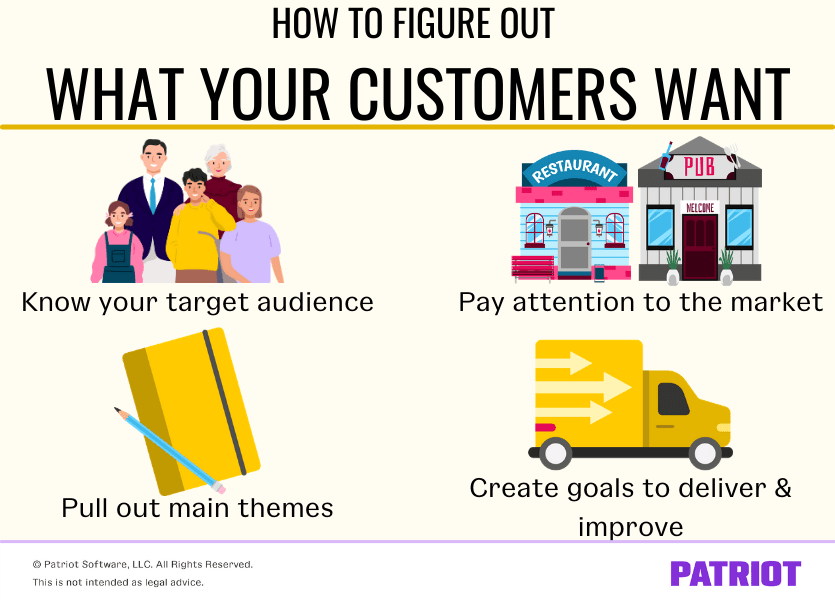Why do customers choose your competitors instead of you? It could be because you’re not giving them what they want. So, what do customers want?
Maybe your target market craves a lower price, better service, higher-quality products, or trust. It’s up to you to figure out what’s most important to your customers … before your competitors beat you to it.
What do customers want?
If you want to answer What do consumers want?, you need to think like a consumer. Luckily, you are a consumer—both in your personal life and business. So, identifying consumer needs should be easy.
Think about what you want from your vendors when making a business purchase. If you own a B2B (business to business) business, your customers might want something similar.
Especially take into account what you look for when shopping for products or services in your personal life if you run a B2C (business to consumer) business.
Write out the things that matter most to you when making purchases. And, consider some of the things that matter most to other consumers, like:
- Low prices
- Customer service
- High-quality products
- Connections
- Trust
- Convenience
- Shopping experience
- Personalization
Keep in mind that not all of these consumer considerations apply at every business. If you’re trying to meet your consumers’ needs of providing the highest quality products, you might not have the lowest prices around.
That’s why knowing your consumers and what they need in particular is oh-so-important.
How to figure out what your customers want—and deliver
OK, so you might have an idea of what the general consumer wants and needs from their brands of choice. But, none of that matters if you don’t know what your specific customers want.

1. Know your target audience
Remember that market analysis you did before starting your business? The market analysis is key to learning who your target audience is and how to market to them.
If you don’t know your target customers like the back of your hand, it’s time to pull out that market analysis again. Your market analysis should detail customer information like:
- Age
- Income
- Gender
- Location
- Occupation
Why does this matter? Everything from the products you develop or the services you provide to the marketing that you do depends on who you’re hoping to sell to.
If you’re selling to customers all over the country via an online store, they might value convenience more than someone who has to drive to a brick-and-mortar. And, a target audience consisting of college students might value a good bargain more than anything.
Of course, you don’t want to just speculate based on educated guesses. You want to hear what your customers want, straight from the horse’s mouth.
There are a few ways you can learn more about your target audience and what they want. First, you can gather feedback directly from consumers in your target audience. Think email, social media, or even paper surveys.
Second, consider pulling in your employees—the ones who work directly with customers. Your employees likely receive a good amount of feedback in their everyday interactions with customers.
2. Pay attention to the market
What do customers look for in a business? Well, it depends on the market. What matters most to a customer one year might be completely different the next. Why?
Because the market is always changing. The economy and trends can make a difference in what consumers want—or think they want.
Take the coronavirus, for instance. Fear of the virus prompted a rise in consumers valuing convenient ways of shopping, like curbside pickup or delivery. The economic decline due to higher unemployment rates may have led some consumers to value low prices more than before.
If you want to learn what’s happening in the market, pay attention to the news. Look at what’s trending (e.g., rise in consumers who want personalized service). And, check out how the economy is doing to determine how it could impact what consumers want.
3. Pull out the main themes
Identifying customer needs and wants is key to delivering. So once you narrow down your target audience, gather feedback, and research the market, you can pull out the main themes.
You might not be able to appease every customer. After all, what one individual wants might be far off from what another wants. But, you can hone in on the most common feedback responses. See how it matches up to the research you’ve done on your overall target audience, recent trends, and economic conditions.
4. Create goals to deliver and improve
After you have concrete ideas about what your consumers want from your business, create goals to deliver. More than likely, you can’t deliver overnight.
Instead, set goals to improve the areas your target audience sees the most value in. For example, you may decide to hire more employees and go through training if your customers value customer service.
Whatever it is that customers want, lay out what the goal is and how you can work towards delivering it. Set a timeline to help you stay on track.
Again, what your customers want today isn’t always going to be what they want tomorrow. Constantly revisit your business goals and the research they’re based on to meet your customers where they are for years to come.
This is not intended as legal advice; for more information, please click here.



